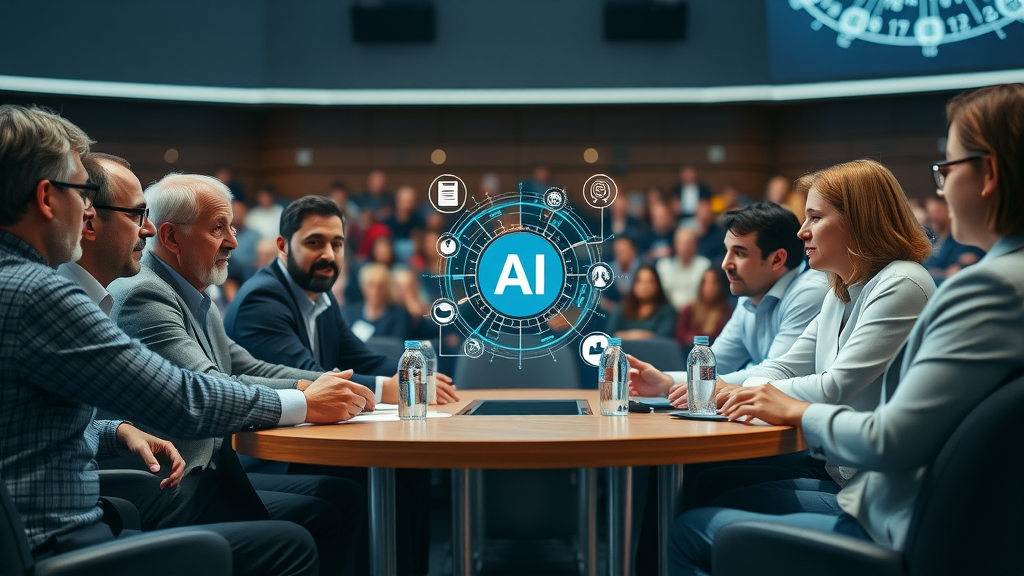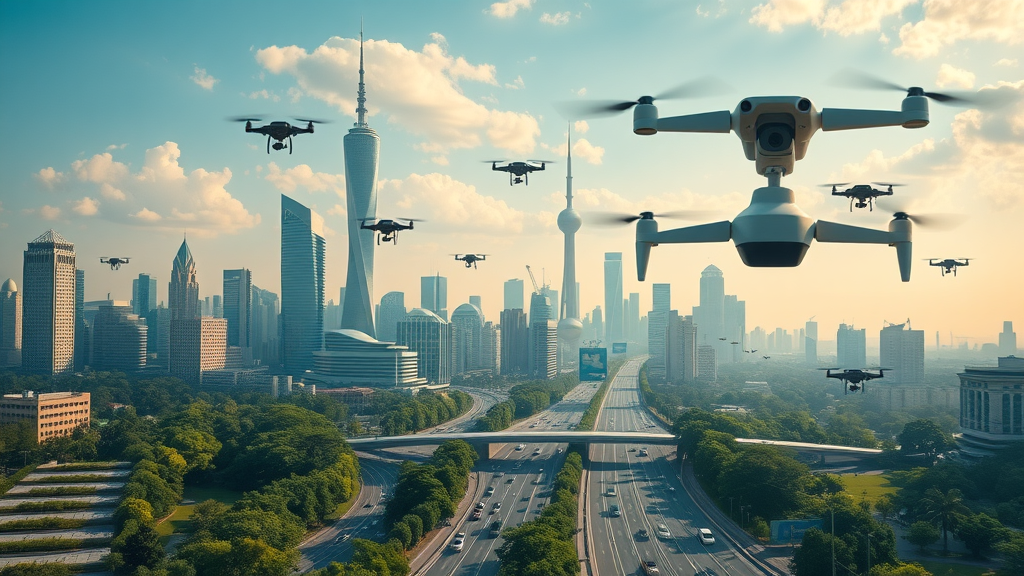Introduction: The Unpredictable Trajectory of AI Future Growth Potential
AI’s next big leap may not be as dramatic as anticipated. While the world expected artificial intelligence to unleash an unprecedented surge in productivity, recent data tells a more nuanced story. Despite massive attention and investment in AI technologies, the much-hyped jump from ChatGPT 4.0 to 5.0 didn’t revolutionize workplaces, transform global markets, or deliver seismic shifts in efficiency. As businesses and industries race to harness AI future growth potential, it’s crucial to separate fact from fiction and understand the real direction AI adoption, AI models, and the global AI market are truly taking.
"Despite the hype, the leap from ChatGPT 4.0 to 5.0 failed to produce the seismic productivity boost many expected."
A Startling Statistic: Is AI Plateauing?
The introduction of GPT-4.0 was met with sky-high expectations, but just 12 months after deployment, reports show only a 2–3% uptick in average knowledge worker productivity—far below the anticipated double-digit gains. This slowdown is echoed across sectors that rushed to deploy new AI models and AI tools. As the initial euphoria around rapid growth gives way to data-driven skepticism, business leaders and AI researchers are now questioning whether the era of exponential progress in generative AI and machine learning is winding down. Understanding AI future growth potential required deeper investigation—not just hope.

What You'll Learn About AI Future Growth Potential
Unexpected limitations in generative AI
Implications for AI adoption and market direction
Where the AI market is truly headed
The real-world impact and reach of global AI
The Promise Versus Reality: Artificial Intelligence and AI Market Today
When artificial intelligence first burst into mainstream awareness, the promise was clear: a global AI transformation marked by explosive gains in productivity, efficiency, and capability across every business function. Headlines spoke of a $15.7 trillion AI market by 2030. AI applications in customer service, financial services, and even autonomous vehicles were forecasted to disrupt everything from supply chains to healthcare delivery. Yet, recent adoption rates suggest otherwise: businesses are still grappling with technical bottlenecks, integration challenges, and a noticeable lag in turning AI investment into real-world, scalable ROI. The gulf between AI technology promises and results is growing increasingly clear.
This divergence is generating new conversations among business leaders, AI researchers, and policymakers. Where earlier optimism saw every AI model as an easy solution for boosting output and streamlining workflows, recent market realities show that real adoption of AI solutions is far more complex. AI governance, data quality, and compliance now loom as major hurdles, further questioning whether talk of AI future growth potential might be years ahead of today’s practical achievements.
How the Global AI Hype Shapes Expectations
Investor excitement and media stories have painted artificial intelligence as the centerpiece of the next industrial revolution. Tech expos and venture forums routinely spotlight AI startups promising world-changing breakthroughs in generative AI and deep learning. But this headline-driven optimism can distort both public and boardroom expectations: C-suite leaders may feel pressured to fast-track AI adoption, even when the supporting infrastructure and datasets fall short. This misalignment creates a dangerous disconnect between market narratives and technical realities, adding pressure on AI models to deliver results that may not be immediately possible.

As global AI hype drives up expectations, companies must guard against costly mistakes by avoiding over-commitment to AI tools, systems, and platforms that promise more than they can deliver. Risking investment on AI’s potential rather than its proven capabilities could leave businesses exposed to competitive threats and operational setbacks just as AI market optimism recedes.
Examining Actual AI Market Data and Adoption Rates
To accurately gauge AI future growth potential, one must look past marketing and into hard numbers. According to recent studies, only 30% of enterprises that experimented with new AI models saw significant process improvements over the past year—down from over 40% in the previous survey cycle. Many AI tools implemented in 2023 failed to outperform earlier systems and required sustained manual oversight, undercutting promises of full automation. AI adoption was more robust in sectors with abundant, structured data (like finance), but lagged in healthcare, supply chain, and education.
Comparison: AI Predictions vs. Actual Outcomes |
||
Metric |
2021 Predictions |
Actual (2023-24) |
|---|---|---|
Worker Productivity Increase (%) |
15–20 |
2–3 |
Economic Growth Attributed to AI (%) |
5–7 |
1.2 |
AI Adoption Rate in Large Enterprises (%) |
60 |
35 |
This gap between projected and actual outcomes underscores the need for organizations to temper short-term expectations. Data shows that while the AI market’s foundation for future scaling is solid, the current productivity limits of many AI systems are increasingly evident.
The Evolution of Generative AI: From Deep Learning to Language Processing
The remarkable journey of artificial intelligence began with innovations in machine learning and deep learning, both of which unlocked capabilities like computer vision and early natural language tasks. Each generation of AI models seemed to promise exponential leaps in algorithmic intelligence, leading to the emergence of generative AI that could write, draw, plan, and converse with surprising nuance. However, as the field matured, so too did the realization that each breakthrough came with new, often unexpected, bottlenecks.
Core advances in natural language processing, such as improved chatbots and AI-driven virtual assistants, raised hopes of automating broad swathes of business function. Yet, in practice, generative AI’s impact was often constrained by issues such as the need for high-quality datasets, energy demand, and integration challenges with legacy systems. The story of AI is one of both dazzling promise and humbling limitations.
Tracing Breakthroughs in Machine Learning and Deep Learning
For much of the past decade, machine learning and deep learning defined the AI landscape, driving innovations in computer vision, speech recognition, and predictive analytics. The advent of large neural networks and advances in training algorithms propelled impressive AI achievements—from AI-powered supply chain optimization to world-beating performance in image classification and natural language translation. The introduction of transformers took things even further, ending the era of simple pattern recognition and paving the way for generative AI models.

Yet, as model complexity increased, so too did the resource requirements. Today’s largest AI systems demand massive amounts of training data and compute power, making further improvements costly and slow. AI research and development teams find themselves balancing the pursuit of AI future growth potential with the realities of scaling, regulatory compliance, and societal expectations.
How Generative AI and Natural Language Processing are Shifting the Landscape
The rise of generative AI and natural language processing (NLP) tools has expanded what AI can do for organizations. Modern solutions can draft marketing content, provide customer service via chatbots, and even generate creative assets. Businesses have shortened development cycles by leveraging AI tools for everything from email sorting to research summarization, marking a genuine step forward in AI adoption. However, many companies still find that these NLP-based AI models struggle with complex, nuanced tasks, such as understanding context or maintaining conversation coherence over time.
While NLP and generative AI continue to evolve rapidly, the “black box” nature of many AI systems creates accountability and transparency issues. AI market leaders are now investing in explainable AI solutions to ensure trust and foster responsible deployment, making the responsible scaling of global AI a leading conversation among stakeholders.
The Surprising Limits in the Latest AI Models
Despite improvements in AI capabilities, new models consistently deliver smaller performance gains—a trend known as diminishing returns. For instance, while GPT-4.0 introduced improved reasoning and memory, GPT-5.0’s headline benefits were far less pronounced. Many in the AI research community now acknowledge that breakthroughs are subject to physical and technical limitations such as hardware cost, algorithmic efficiency, and data scarcity. These bottlenecks mean that the AI market may be close to a plateau, at least in the short term, raising critical questions about how to pursue AI’s future growth potential and where to prioritize research and development efforts.
"Each new AI model delivers diminishing returns compared to earlier iterations." —AI Research Analyst
As investment pours into making AI tools more accessible and reliable, stakeholders must tackle the challenge of balancing ambition with realism. Scaling generative AI, natural language processing, and deep learning will depend on technical breakthroughs and smarter governance, not just raw compute power.
AI Model Plateaus: Understanding Productivity Slowdown
The much-heralded jump from ChatGPT 4.0 to 5.0 marks an important reality check: the scaling curve for AI systems is flattening. New models require exponentially more data, computing resources, and energy to produce only fractionally better outcomes for everyday business function. In practice, the incremental value of each new AI tool is often outweighed by the cost and complexity of integration. Enterprises investing heavily in AI adoption are now reexamining their strategies, seeking solutions that offer proven, sustainable returns rather than speculative breakthroughs.
Within the global AI landscape, even the most advanced organizations are beginning to report that the productivity benefits of newer AI models are stalling—sometimes even causing operational headaches when models overpromise and underdeliver. For AI future growth potential, understanding these slowdowns is critical for making informed, data-driven decisions in the coming decade.
Productivity Stagnation Between ChatGPT 4.0 and 5.0
Comparing ChatGPT 4.0 and 5.0 across benchmark tasks, industry studies found just a 1–2% jump in aggregate productivity—a far cry from the leaps seen in earlier versions. Many business users report that newer AI solutions offer better interface polish, but not transformative improvements in analytical depth or creative capacity. Administrative and knowledge-based roles that once saw double-digit productivity increases with initial AI deployment are now experiencing marginal gains.

This stagnation is prompting business leaders to ask whether the AI model development approach—focused on scaling up size and compute—remains viable. With costs rising and return on investment narrowing, the AI market seems ripe for a strategic reset, prioritizing smarter use of resources and more targeted AI research efforts.
Technical Barriers Facing AI Models and AI Adoption
Scaling AI systems today faces a raft of technical hurdles. Top among them are data limitations: most business function areas lack the huge, clean, labeled datasets required to train state-of-the-art AI tools effectively. Model plateau is compounded by regulatory uncertainties around data privacy and security, which affect innovation and cross-border collaboration. High energy consumption for training deeper networks is another major constraint, putting pressure on both budgets and sustainability goals.
These challenges highlight a growing divergence between what’s technically possible and what’s commercially, environmentally, and legally viable. As businesses consider the adoption of AI tools for ongoing digital transformation, many are now adopting a “wait and see” approach—only embracing AI solutions once clear, demonstrable value is evident.
How Customer Service, Global AI, and AI Research are Affected
Sectors like customer service have been quick to test and deploy natural language processing-based AI models for chatbots and virtual assistants. However, when these AI applications hit data or regulatory bottlenecks, performance plateaus quickly. Similar patterns are seen across the global AI industry, where national and regional differences in data law stymie large-scale deployment and cross-border innovation.
Data limitations
Lack of quality datasets
Energy consumption
Regulatory bottlenecks
The result: Even the most ambitious AI research and development programs must reconcile their goals with these real-world inhibitors, forcing a shift in strategy toward sustainable, incremental advances in AI technology.
Counterpoint: Where Does the AI Market Go From Here?
Even as scaling slows, the story of AI future growth potential is far from over. Many experts believe that a new wave of innovation is set to emerge, driven not by supersized AI models but by targeted breakthroughs in fields like computer vision, machine learning, and language processing. By focusing on hybrid AI systems—ones that combine symbolic reasoning with deep learning—or on industry-specialized applications, businesses and researchers can unlock new efficiencies and expand the reach of artificial intelligence in practical, profitable ways.
The next phase of the AI market will likely be defined by smarter, not bigger, AI: more energy-efficient algorithms, context-aware AI applications, and tighter integration with human expertise. This approach—sometimes called the “AI second wave”—offers the best prospects for real-world impact, delivering benefits where they matter most.
Potential for Innovation in Computer Vision, Machine Learning, and Language Processing
Computer vision, once a science fiction concept, is now revolutionizing fields from manufacturing to medical imaging with targeted advancements that require less data and energy than ever before. Recent machine learning research is emphasizing efficiency and interpretability, not just raw performance. Language processing is evolving too, as NLP tools grow more adept at understanding not just syntax but human intent—a leap instrumental for better customer service and business analytics.

The challenge now is to channel investment, AI research, and talent pool toward domains with high potential for real impact—moving from generic, mega-scale AI models to tools specifically optimized for industry needs, societal values, and long-term viability.
What Artificial Intelligence Can Still Deliver for Business and Society
Artificial intelligence, when deployed strategically, still offers transformative value—increasing efficiency in supply chains, elevating customer experiences with faster, more relevant support, and unlocking new frontiers in healthcare, logistics, and education. Global AI initiatives continue to explore how AI systems can optimize energy consumption, reduce waste, and streamline research and development, ensuring that meaningful progress continues even amid slower scaling.
The future of AI is rooted in responsible adoption and purposeful integration, not just major breakthroughs. By concentrating efforts on areas where real productivity and societal benefits can be achieved, organizations ensure that the pursuit of AI future growth potential remains grounded in reality.
Critical Insights Into AI Adoption and AI Research Directions
As the AI market matures, winning strategies will depend on a balanced understanding of both limitations and opportunities. Insightful leaders focus on scalable, cost-efficient AI tools, promote collaboration between AI experts and business units, and prioritize explainability, ethics, and transparency. AI adoption will accelerate hardest in domains prepared to bridge the “last mile” of integration, supporting human users and business function instead of aiming for full automation.
In research, directions are shifting toward AI governance, data stewardship, explainable models, and reduced environmental impact. This sober, realistic approach will help unlock AI’s future growth—a path marked not by explosive jumps, but by stable, impactful, societally aligned progress.
Lists: Key Drivers and Limitations of AI Future Growth Potential
AI Drivers: Investment, compute power, talent pool, regulatory support
AI Limitations: Model plateau, real-world adoption lag, societal trust

Watch leading researchers and business executives break down today’s AI reality versus hype, highlighting data-driven perspectives on future directions, slowdowns, and emerging opportunities.
People Also Ask: What Will AI Be in 5 Years?
Short-Term Predictions for AI Market and Generative AI
Over the next five years, the AI market is projected to experience incremental, not exponential, improvements. Sectors that are data-rich and highly automated—like financial services and logistics—will likely see the greatest benefits from evolving generative AI and natural language processing technologies. Still, companies must temper expectations, as regulatory scrutiny and model plateau will limit truly disruptive advances.

Answer: Experts predict incremental improvements rather than exponential leaps, especially as artificial intelligence contends with plateaued productivity and regulatory scrutiny.
Leading voices in AI research anticipate slow but steady enhancements in AI capabilities, with a greater focus on solving industry-specific challenges rather than universal breakthroughs. Efforts will center around making systems more transparent, ethically aligned, and resilient to risks, gradually increasing trust and adoption across markets.
People Also Ask: Which 3 Jobs Will Survive AI?
Jobs With Staying Power Amidst Artificial Intelligence Disruption
Not all jobs are equally vulnerable to automation by artificial intelligence. Those that require deep creativity, strategic thinking, or empathetic human input—like healthcare providers, senior educators, and advanced engineers—are among the most likely to thrive. AI technology, with its limits in contextual understanding and emotional intelligence, is more likely to assist these roles than replace them outright.

Answer: Roles demanding creative, strategic, or empathetic human input—such as healthcare providers, senior educators, and advanced engineers—are projected to remain essential despite growing AI adoption.
The survival of these professions is anchored in the uniquely human expertise they require. As global AI systems become more prevalent, hybrid models of collaboration—where AI tools support rather than supplant skilled workers—will define the future of work.
People Also Ask: What Is the Future of AI in 20 Years?
Long-Term Outlook for Global AI and Machine Learning
Over a 20-year horizon, the integration of global AI and machine learning into society is expected to deepen. While disruptive breakthroughs will be less frequent, AI systems will become more holistic—integrating seamlessly with urban infrastructure, public health systems, and everyday digital services. The maturing AI market will be driven by regulatory frameworks, societal acceptance, and a relentless emphasis on ethical AI governance.

Answer: Artificial intelligence is poised for wider but more measured integration, driven by societal needs and a maturing AI market rather than rapid, unpredictable disruption.
AI will evolve from a disruptive force to a foundational technology, quietly optimizing everything from traffic management to healthcare delivery. Its effect will hinge on how societies choose to regulate, trust, and ethically deploy these advancements.
People Also Ask: What Will AI Look Like in 2050?
Speculative Scenarios: AI Models, Human Collaboration, and Societal Shifts
Looking ahead to 2050, AI will likely be omnipresent—embedded within homes, schools, city grids, and the economy’s fabric. Co-evolution of humans and AI systems will shift from competition toward collaboration, as regulatory, ethical, and productivity constraints from today's plateau steer the design of future AI models. Human oversight will remain crucial, ensuring AI stays aligned with societal priorities and safety.

Answer: By 2050, AI will likely be seamlessly embedded into most aspects of daily life, yet its role will be shaped by ethical, legal, and productivity constraints emerging from today's scaling challenges.
The agenda for AI future growth potential will shift towards sustainable, integrated solutions. Models will be designed with transparency and user empowerment in mind, responding to lessons learned from periods of unchecked scaling and hype.
FAQs: Your AI Future Growth Potential Concerns Answered
Which industries will benefit most? Industries such as healthcare, finance, logistics, and customer service are set to benefit first and most from maturing AI technology—given their abundance of structured data and pressing needs for efficiency gains.
How safe is generative AI? When properly regulated and deployed, generative AI can be secure and reliable. However, ongoing oversight, robust governance, and continuous testing are necessary to manage risks like bias or data leakage.
Will machine learning replace human creativity? No—while machine learning can boost productivity and provide insights, true creativity relies on human context, emotion, and judgment. AI tools are best deployed as assistants, not as replacements, for uniquely human talents.
Explore a recent panel of industry thought-leaders and AI researchers as they examine the divide between hype and reality in AI market growth, discuss common barriers, and propose pragmatic strategies for achieving sustainable progress.
Key Takeaways: A Realistic Approach to Maximizing AI Future Growth Potential
Be cautious of hype cycles; focus on real ROI from artificial intelligence tools and systems.
Track advances in AI research and invest prudently—as scaling slows, patience and selectivity will be rewarded.
Future-proof your skills and organizational processes; embrace a long-view, prioritizing explainable AI, ethics, and responsible governance.
Conclusion: Charting a Path Forward for AI Future Growth Potential
"AI's future may not be about explosive growth, but sustainable, meaningful integration into society."
Why the Counter-Narrative is Essential for Strategic Decision-Makers
In a world racing to unlock the next AI breakthrough, sober clarity is a competitive advantage. Leaders who heed the counter-narrative—acknowledging model plateaus, investing in responsible governance, and grounding decisions in data, not hype—will chart the smartest path forward for their organizations and for society.

Take Action: Reassess your AI strategy—let data and pragmatism, not hype, drive your next move.
The journey ahead for the AI future growth potential belongs to those who prioritize sustainable, meaningful integration over the allure of runaway scaling. Now is the time to act with insight, resilience, and purpose.
The article “Is AI hitting a wall?” examines the recent stagnation in AI development, particularly highlighting the underwhelming performance of OpenAI’s GPT-5. Despite expectations of significant advancements, GPT-5 offered only minor improvements over its predecessor, raising concerns about the diminishing returns of scaling large language models. This analysis underscores the need for the AI industry to explore diverse approaches beyond merely increasing model size. (ft.com)
Similarly, “The hidden economics of AI: balancing innovation with reality” delves into the economic challenges associated with AI adoption. The article reveals that, despite substantial investments, only a small fraction of companies are realizing enterprise-wide benefits from generative AI deployments. It emphasizes the importance of strategic planning and robust infrastructure to bridge the gap between AI’s potential and its actual business impact. (techradar.com)
For a comprehensive understanding of the current state and future trajectory of AI, these resources provide valuable insights into both the technological and economic dimensions of AI development.
 Add Row
Add Row  Add
Add 




Write A Comment